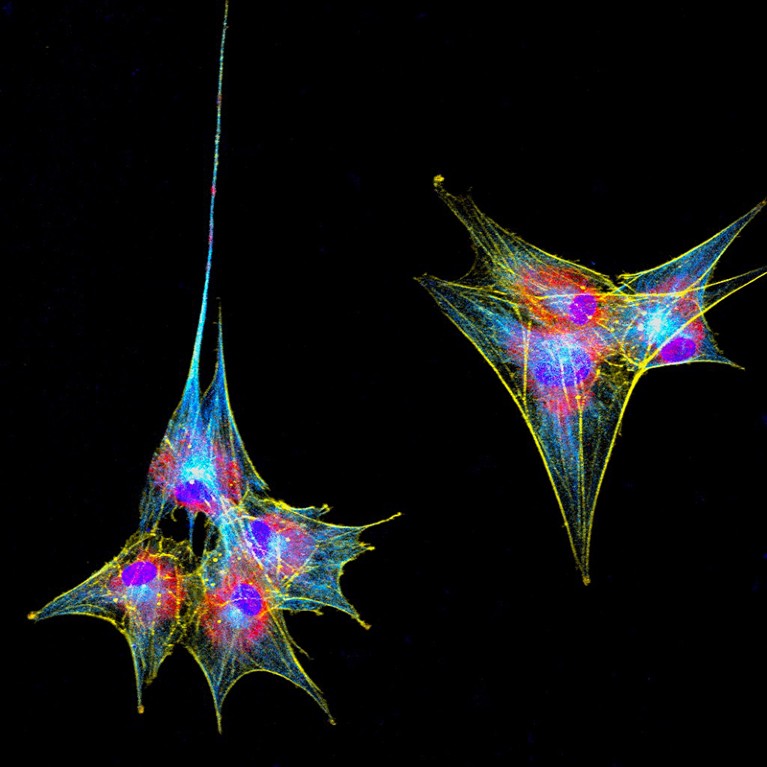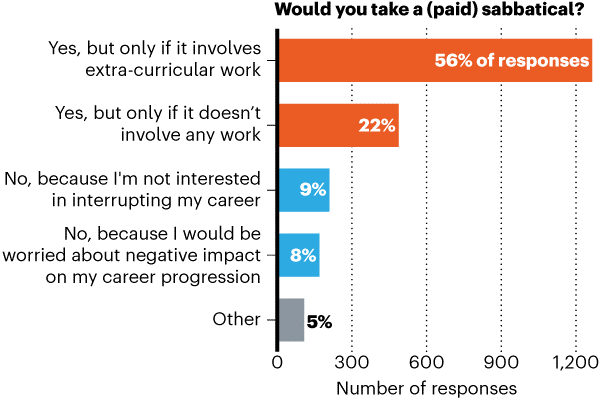Hello Nature readers, would you like to get this Briefing in your inbox free every day? Sign up here.

Credit: Shuntaro Yamada, University of Bergen
Under the right conditions, stem cells from the innermost layer of the tooth — known as dental pulp — can be coaxed into forming neuronal cells (pictured here) with specific shapes and features, says stem-cell biologist and dentist Shuntaro Yamada. Dental-pulp cells are derived from the neural crest, the part of an embryo that goes on to form the nervous system as well as bones in the face and skull. Researchers hope that dental-pulp stem cells could one day find applications in regenerative medicine.
See more of the month’s sharpest science shots, selected by Nature’s photo team.
Nature | Leisurely web scroll
With the United States National Science Foundation recommending a cap on available funding for telescope projects, it seems that only one of two proposed telescopes could be built. The Giant Magellan Telescope on a mountaintop in Chile and the Thirty Meter Telescope on the Hawaiian mountain Mauna Kea have long been mooted, but struggled to secure the necessary backing. Meanwhile, the European Southern Observatory is proceeding with the Extremely Large Telescope in Chile. To some US researchers, the idea of having only one large telescope represents a major blow to US leadership in astronomy.
Nature | 5 min read
The blue whale (Balaenoptera musculus), which tops out at around 150 tonnes, might have reclaimed its crown as the undisputed heaviest animal of all time. Last August, we told you that fossil evidence suggested that Perucetus colossus, which lived around 30 million years ago, was heavier — around 180 tonnes. Not so fast, says a new study: Perucetus was considerably shorter than a blue whale and being so dense meant “it would have been a job for the whale to stay at the surface, or even to leave the sea bottom,” says paleobiologist Ryosuke Motani. Using a different estimate of its body shape, Motani and colleague Nicholas Pyenson estimate Perucetus weighed in at more like 60 to 70 tonnes.
The New York Times | 4 min read
Reference: PeerJ paper
Researchers have discovered the first example of communication between individual parts of a molecular machine. “The motor [behaves] as two motorised gears — the two rotors — connected via a third gear, the motor core unit,” explains chemist and study co-author Carlijn van Beek. Similar coupled motion is seen in biological machines such as ATP synthase, the enzyme that creates the energy storage molecule ATP. “Although the ATP synthase is clearly capable of much more sophisticated functions than our synthetic motor … the development and control of molecular-level motions will open many possibilities,” says van Beek.
Chemistry World | 4 min read
Reference: Journal of the American Chemical Society paper
Reader poll
Table of Contents

Last week, we heard from metascientist Jordan Dworkin, who suggests that academics can boost their research by taking a sabbatical from science to work in government. And medical researcher Brandon Brown says that a work-free sabbatical helped him to find a better work–life balance and remember why he got into academia in the first place.
Almost 80% of readers who replied to our poll said they would take a (paid) sabbatical, with the majority wanting to use the time to volunteer or do extracurricular work. Some suggested there should be an option to do sabbatical work within one’s field of expertise: “It gives me the chance to continue and enrich my lines of research working with a different group,” explains physicist Julio Herrera-Velázquez.
“I’d take a sabbatical from private industry to be an academic for a year,” says geologist Chris Schneider. “To finish the backlog of scientific papers that I could be writing from the data I’ve collected over the years.”
While respondents who would prefer a work-free break were in the minority, for medical researcher Adrien Schvartz taking a six-month sabbatical to cycle along the Australian East Coast was “the best life decision — and work-decision — I ever made at the time. I met people I would have never met otherwise, and overall became a kinder and more open-minded person.”
Features & opinion
In his new book Pathless Forest, botanist Chris Thorogood delves into his obsession with Rafflesia — the huge, parasitic, stemless, rootless, leafless, stinking ‘corpse flower’. The endangered plant comes to personify nature’s untamed essence — it is almost impossible to propagate or even successfully store in seed banks — and sheds light on the colonial legacies intertwined with botanical exploration.
The Guardian | 4 min read
Author Yelena Crane crafts a heart-rending tale about the exploitation of historical trauma in the latest short story for Nature’s Futures series.
Nature | 6 min read
Andrew Robinson’s pick of the top five science books to read this week includes a stimulating analysis of moral dilemmas in artificial intelligence and a collection of essays on topics such as climate justice, written by Native American leaders.
Nature | 4 min read
Dwarf galaxies were responsible for ending the early Universe’s dark ages, dispelling the dense ‘fog’ of neutral hydrogen that blocked starlight until around 13 billion years ago. It had been unclear where the ionizing radiation for this reionization process came from. Researchers who used the James Webb Space Telescope to peer deep into the Universe’s past found a huge number of small, faint galaxies that were extremely efficient ionizers. “It’s the little tiny galaxies that, by their numbers, actually outshine the big galaxies,” astrophysicist and study co-author Hakim Atek tells the Nature Podcast.
Nature Podcast | 26 min listen
Subscribe to the Nature Podcast on Apple Podcasts, Google Podcasts or Spotify, or use the RSS feed.
Today I’m engrossed in one man’s gorgeous map of Scotland made from rocks collected from every corner of the country. Amateur geologist Harry Young spent 30 years making the map, so I’d better get started if I want one of my own.
In our penguin-spotting game, Leif Penguinson is also celebrating Scotland’s natural beauty — on or near the coastal cliffs of Handa Island. Can you find the penguin?
The answer will be in Monday’s e-mail, all thanks to Briefing photo editor and penguin wrangler Tom Houghton.
Thanks for reading,
Flora Graham, senior editor, Nature Briefing
With contributions by Katrina Krämer, Sarah Tomlin and Sara Phillips
Want more? Sign up to our other free Nature Briefing newsletters:
• Nature Briefing: Anthropocene — climate change, biodiversity, sustainability and geoengineering
• Nature Briefing: AI & Robotics — 100% written by humans, of course
• Nature Briefing: Cancer — a weekly newsletter written with cancer researchers in mind
• Nature Briefing: Translational Research covers biotechnology, drug discovery and pharma
